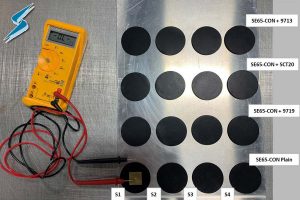Contact Stockwell Elastomerics
Request a quote or get more information.
Electrically conductive silicones combine the best of silicone’s properties, such as temperature stability, UV resistance, and elastomeric waterproofing, with electrical conductivity for ESD, EMI, and RFI protection. These materials are compounded with conductive fillers such as carbon or metal particles to create an electrical path through the silicone. Stockwell Elastomerics’ SE65-CON is an electrically conductive silicone rubber that provides this combination of environmental and electrostatic discharge protection ideal for shielding electronics and electrical devices. It is available in flat stock, cut gasket, and compression molded form. View SE65-CON datasheet (PDF) for technical details on this material.
SE65-CON and other high performance conductive silicones can be supplied with either acrylic or silicone conductive adhesives thanks to Stockwell Elastomerics’ proprietary lamination process. 3M 9713 conductive acrylic pressure sensitive adhesive (PSA) provides a strong tack for the most rigorous requirements, while also enabling an electrical path through the Z-axis. 3M 9719 conductive silicone PSA allows the highest level of conductivity through to the housing, but due to the nature of silicone adhesives, it lacks some of the strength of an acrylic bond.
 To determine the particular differences between these material and conductive adhesive combinations and to support customers’ needs, Stockwell Elastomerics’ engineering team has launched an investigation into the Z-axis conductivity of these materials. This test measures the resistance through the material and its adhesives both in the time shortly after application and after the adhesive has wetted out into the material and its bond surface. To add to the experiment and gauge with other offerings, Adhesive Applications’ SCT20 conductive silicone transfer adhesive was also tested.
To determine the particular differences between these material and conductive adhesive combinations and to support customers’ needs, Stockwell Elastomerics’ engineering team has launched an investigation into the Z-axis conductivity of these materials. This test measures the resistance through the material and its adhesives both in the time shortly after application and after the adhesive has wetted out into the material and its bond surface. To add to the experiment and gauge with other offerings, Adhesive Applications’ SCT20 conductive silicone transfer adhesive was also tested.
The results of this testing show a side-by-side comparison between a plain sample of SE65-CON and a sample with various adhesives. The SE65-CON with SCT20 demonstrated similar performance to a plain sample. The SE65-CON with 3M 9719 showed a significantly lower resistance than any other combination tested, as well as handily outperforming the plain material. The SE65-CON with 3M 9713, while still conductive, failed to reach the low resistivity levels shown by the other adhesive combinations tested. The application of 3M 9713 created a small but significant insulating effect on the SE65-CON.
All the adhesives tested improved conductivity after a 24 hour wet-out period, and held relatively stable beyond that time to 72 hours. This wet-out dispersal may be the reason that the 3M 9719 adhesive is able to outperform plain material: by filling in the gaps between surfaces with conductive material, it reduces the electrical contact resistance.
Stockwell Elastomerics’ proprietary lamination process enables the lamination of acrylic adhesives to silicone substrates, providing stronger tack and a longer shelf life. However, to a certain degree, it can limit Z-axis conductivity. For these reasons, there are many trade-offs to be weighed between conductive acrylic 3M 9713 PSA (datasheet PDF) and conductive silicone 3M 9719 PSA (datasheet PDF).
Contact a Stockwell Elastomerics Application Engineer for help with selecting conductive silicones and adhesives solutions for specific applications.
Request a quote or get more information.
